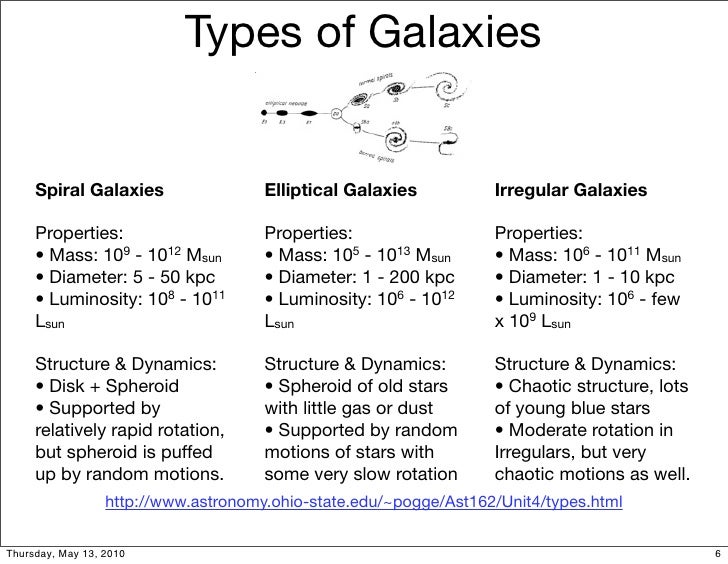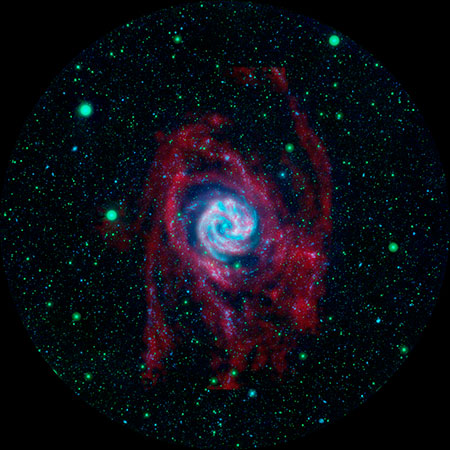A this point in the age of our universe, and at the current point of astronomical knowledge, what can be concluded about the characteristics of the "average galaxy"? Are most galaxies spirals? How massive is the average galaxy, and how many stars does it contain?
Finally, how does the Milky Way compare to the average? Is the Milky Way typical, or atypical?
Bruce
The Average Galaxy vs the Milky Way
-
BDanielMayfield
- Don't bring me down
- Posts: 2524
- Joined: Thu Aug 02, 2012 11:24 am
- AKA: Bruce
- Location: East Idaho
The Average Galaxy vs the Milky Way
Just as zero is not equal to infinity, everything coming from nothing is illogical.
- neufer
- Vacationer at Tralfamadore
- Posts: 18805
- Joined: Mon Jan 21, 2008 1:57 pm
- Location: Alexandria, Virginia
Re: The Average Galaxy vs the Milky Way
BDanielMayfield wrote: ↑Sun Sep 16, 2018 9:37 pm
A this point in the age of our universe, and at the current point of astronomical knowledge, what can be concluded about the characteristics of the "average galaxy"? Are most galaxies spirals? How massive is the average galaxy, and how many stars does it contain?
Finally, how does the Milky Way compare to the average? Is the Milky Way typical, or atypical?
- Just as most stars are dwarfs
(and most "planets" will probably turn out to be dwarfs)
...so most galaxies are dwarfs:
https://en.wikipedia.org/wiki/Galaxy#Dwarfs wrote:
<<Despite the prominence of large elliptical and spiral galaxies, most galaxies in the Universe are dwarf galaxies. These galaxies are relatively small when compared with other galactic formations, being about one hundredth the size of the Milky Way, containing only a few billion stars. Ultra-compact dwarf galaxies have recently been discovered that are only 100 parsecs across.
Many dwarf galaxies may orbit a single larger galaxy; the Milky Way has at least a dozen such satellites, with an estimated 300–500 yet to be discovered. Dwarf galaxies may also be classified as elliptical, spiral, or irregular. Since small dwarf ellipticals bear little resemblance to large ellipticals, they are often called dwarf spheroidal galaxies instead.
A study of 27 Milky Way neighbors found that in all dwarf galaxies, the central mass is approximately 10 million solar masses, regardless of whether the galaxy has thousands or millions of stars. This has led to the suggestion that galaxies are largely formed by dark matter, and that the minimum size may indicate a form of warm dark matter incapable of gravitational coalescence on a smaller scale.>>
Art Neuendorffer
-
BDanielMayfield
- Don't bring me down
- Posts: 2524
- Joined: Thu Aug 02, 2012 11:24 am
- AKA: Bruce
- Location: East Idaho
Re: The Average Galaxy vs the Milky Way
Thanks for that very informative and somewhat unexpected reply Art. I didn't expect the current number of dwarf galaxies to be anywhere near that large.
Bruce
Bruce
Just as zero is not equal to infinity, everything coming from nothing is illogical.
Re: The Average Galaxy vs the Milky Way
My impression is that the Milky Way is the Milky Way is large-ish even as "big galaxies" go. (Just like our Sun is quite massive as a star, even though it is truly dwarfed by the largest and most massive stars in the Universe.)BDanielMayfield wrote: ↑Sun Sep 16, 2018 9:37 pm A this point in the age of our universe, and at the current point of astronomical knowledge, what can be concluded about the characteristics of the "average galaxy"? Are most galaxies spirals? How massive is the average galaxy, and how many stars does it contain?
Finally, how does the Milky Way compare to the average? Is the Milky Way typical, or atypical?
Bruce
According to this "comparison chart" from ohio-state.edu, masses of spiral galaxies typically range from 109 to 1012 times the mass of the Sun. And according to this research done by Thomas Callingham et al, the mass of the Milky Way may be pretty much exactly 1 x 1012 solar masses.
NGC 3344. Photo: Adam Block.
My amateur impression as a galaxy nerd is that the most elegant Sc galaxies are often more lightweight than the Milky Way.
Look at the picture by Adam Block of NGC 3344 at right. To me this galaxy looks very delicate. The center is small and not exceedingly bright, and the arms are beautifully symmetrical. There are very few obvious mass concentrations in the arms. A galaxy that is so symmetrical, and which has a small and not very bright center, can't be expected to be very massive, in my amateur opinion. Anyway, according to this APOD, NGC 3344 is only about 40,000 light-years in diameter, which makes it very much smaller than the Milky Way.
M83. Photo: Robert Gendler.
M83 with outer arms. Photo: GALEX.
But look at this: According to GALEX, the now-defunct ultraviolet space telescope of NASA, M83 has a huge set of faint but radio-bright outer arms! Perhaps M83 is not so lightweight after all?
Malin 1. Artist's impression.
Appearances aren't everything. A galaxy can appear to be faint and small, even though it might be embedded in a truly humongously large and massive dark matter halo, like Malin 1. Do read the Wikipedia entry about Malin 1.
As for dwarf galaxies, it was an interesting observation by Art that most dwarf galaxies contain a mass of about 10 million solar masses. This would appear to be quite true. I checked up a random dwarf galaxy, Leo 1, and according to Wikipedia its mass is "at least (2.0 ± 1.0) × 107 M☉. Pretty good! But there are dwarf galaxies that are smaller:
AnnSpace.com wrote:
An ultra-faint collection of 1,000 stars orbiting the Milky Way is the most lightweight galaxy ever discovered, scientists say.
...
Segue 2 has a luminosity just 900 times that of our sun, the researchers report. The Milky Way, meanwhile, is 20 billion times brighter.
What sets Segue 2 apart from a star cluster is the dark matter halo that acts as the galaxy's glue, another study researcher, Evan Kirby, explained in a statement.
Color Commentator
-
BDanielMayfield
- Don't bring me down
- Posts: 2524
- Joined: Thu Aug 02, 2012 11:24 am
- AKA: Bruce
- Location: East Idaho
Re: The Average Galaxy vs the Milky Way
Ann, thanks for that detailed post. This info about dwarf galaxies reminds me very much of the what is the lower limit for an object to be a planet debate. Segue 2 is a galaxy? Only 1,000 stars? Sounds like making a mountain out of a mole hill.
Bruce
Bruce
Just as zero is not equal to infinity, everything coming from nothing is illogical.




